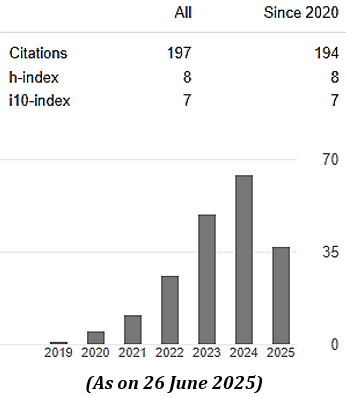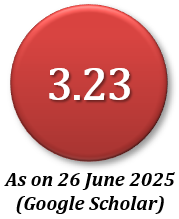Editorial Process
Manuscript Submission (Author & Executive Editor)
In the submission process for all manuscripts intended for publication, the following steps are taken:
- Receipt and Review by Editorial Board: All submitted manuscripts are received by the Editorial Board.
- Examination by Executive Editor (or Associate Editor): The Executive Editor or one of the Associate Editors examines all submitted files, which include the cover letter, text files, graphs, charts, and figures. This review ensures that the submitted files meet the technical and formatting requirements of the journal.
- Acknowledgement and Manuscript ID: If the submitted files meet the journal's technical and formatting requirements, the authors receive an acknowledgment of their manuscript submission. Additionally, a unique manuscript ID number is assigned to the submission. Authors are then requested to include this manuscript ID number in all correspondences with the journal. This ID number helps in tracking and referencing the manuscript throughout the review and publication process.
Technical Revisions (Executive or Associate Editors)
In cases where the manuscript files do not meet the technical requirements of the journal, the authors are provided with detailed instructions outlining the necessary changes that need to be made to the manuscript. They are then requested to make these changes and resubmit the revised files to the Editorial Board for further consideration. This process ensures that the manuscript aligns with the journal's technical and formatting standards before proceeding with the review and publication process.
First Editorial Review (Section Editor)
Following the initial screening of the manuscript files, the review stage is initiated as follows:
- Assignment to a Section Editor: The manuscript is assigned to a Section Editor by the Executive Editor or Associate Editor.
- Review of Suitability: The Section Editor conducts a review of the manuscript, focusing on the Title, Abstract, and Conclusion (not the entire manuscript), to assess its suitability for potential publication in the journal.
- Determining Suitability: If the manuscript is found to be unsuitable for publication, the Section Editor returns the manuscript to the Executive or Associate Editor, along with their editorial comments explaining the reasons for its unsuitability.
- Editorial Authority: The editorial process empowers the editors to provide rejection comments on any manuscript that does not meet the publishing standards or falls outside the scope of the journal.
- Assignment of Reviewers: If the manuscript aligns with the journal's scope and meets the required standards for possible publication, the Section Editor proceeds to assign reviewers from the journal's database for the peer-review process. This ensures that the manuscript undergoes a thorough and expert evaluation by external reviewers.
Peer Review (Reviewers & Section Editor)
The manuscript is entrusted to external double-blind peer review by the Section Editor, with the typical practice of sending it to two expert peer reviewers.
In the double-blind peer review process, the identities of the peer reviewers are kept confidential and not disclosed to the authors, and conversely, the identities of the authors remain concealed from the peer reviewers. This ensures an equitable and impartial review of every manuscript.
The following steps outline the peer review process:
- Reviewer Acceptance: Reviewers are expected to acknowledge the review request within one week. If a reviewer does not respond, the Section Editor will either inform the Executive or Associate Editors or attempt to contact the reviewer through alternative means, or assign a new reviewer.
- Review Feedback Deadline: After the reviewers accept the review requests, the Section Editor waits until the due date, typically set at 3 to 4 weeks, to receive feedback from the reviewers.
- Soft Reminder: If the review reports are not submitted by the due date, the Section Editor sends a gentle reminder to the reviewers, urging them to submit their reviews.
- Second Editorial Process: After the two review reports are submitted, the second editorial process commences, which involves the evaluation of the reviews and the manuscript to make an informed decision regarding publication.
Second Editorial Review (Section Editor)
Following the return of the manuscript with comments from the peer reviewers, the Section Editor undertakes the following steps:
- Review of Peer Comments: The Section Editor carefully reviews the comments and recommendations provided by the peer reviewers.
- Manuscript Suitability: Based on the feedback from the reviewers, the Section Editor makes a recommendation regarding the manuscript's suitability for publication.
- Initial Decision: The Section Editor, considering the reviewers' comments, recommends the first decision for the manuscript. This decision can be one of the following: acceptance, minor revision, major revision, or rejection.
- Resolution of Divergent Opinions: If the opinions of the two reviewers are divided, the Section Editor may assign the manuscript to a third reviewer to obtain an additional perspective.
- Recommendation Sent to Executive/Associate Editors: The Section Editor's recommendation regarding the acceptance or rejection of the manuscript, based on the comments from the two similar review reports, is communicated to the Executive or Associate Editors. These editors will then use this recommendation to make a final decision on the manuscript's publication status.
Manuscript Revision (Author, Section Editor, Executive/Associate Editors)
Following the review process and the decision made by the Executive/Associate Editor, the authors are promptly informed if any minor or major corrections are required for their manuscript. The editor's and reviewers' comments are also shared with the authors.
At this stage, based on the comments received, the authors may need to make changes to various elements of the manuscript, including the text, figures, tables, and more. Once the necessary corrections have been made, the authors are typically required to submit a "Respond to the Reviewer Comments" form, the updated manuscript, and any other relevant documents to the Section Editor. This ensures that the authors address the reviewers' and editors' feedback and make the required revisions to improve the quality and suitability of the manuscript for publication.
Third Editorial Review (Section Editor and Executive or Associate Editors)
Following the receipt of updates and corrections from the authors, the Section Editor carries out the following steps:
- Verification of Updates: The Section Editor reviews all the updates and corrections made by the authors. If necessary, the Section Editor may engage in discussions with the reviewers to ensure the quality and appropriateness of the changes.
- Recommendation to Executive/Associate Editor: If the Section Editor is satisfied with the updates and corrections and considers the manuscript ready for publication, they send an acceptance or rejection recommendation to the Executive or Associate Editor.
- Final Decision: The ultimate decision regarding the publication of the manuscript is made solely by the Executive Editor. This step is critical in ensuring the manuscript meets the journal's standards and objectives.
- Notification to Authors: The authors are promptly informed about the final decision, whether the manuscript has been accepted for publication or rejected. This transparent communication allows authors to be aware of the outcome and take appropriate action based on the decision.
Page Proof & Copy Editing (Copy Editor, Proofreader, and Executive or Associate Editor)
Upon acceptance of the manuscript, the Copy Editing process is initiated, which involves the following steps:
- Assignment of Copy Editor: The Executive or Associate Editors appoint a copy editor for the manuscript.
- Initial Manuscript Check: The copy editor conducts an initial check of the manuscript and subsequently assigns a proofreader or language editor. Any existing errors or typos related to grammar, punctuation, spelling, and more are corrected by the language editor or proofreader.
- Proofreading and Editing: The proofreader or language editor completes their task within a period of 2 to 3 days and returns the edited version to the copy editor through the online system.
- Stylistic Adjustments: The copy editor further checks the manuscript and aligns its style with the Journal Template.
- Author Proof Check: A PDF proof copy of the manuscript is sent to the author for review. The author is requested to identify and indicate any possible updates or typos in a separate text document. During this stage, making significant or major changes to the manuscript or adding/deleting figures is not recommended. The proof must be returned to the Editorial Board within 2 to 3 days (48 to 72 hours).
- Preparation for Publication: Once the corrected proof is received, the final version of the manuscript is prepared for publication by the Copy Editor.
Manuscript Publication (Production or Executive or Associate Editor)
Following the preparation of the manuscript, the Production stage is initiated by the Executive or Associate Editor. In this stage, a Production Editor is assigned to carry out the following tasks:
- Manuscript Formatting: The Production Editor prepares various formats of the manuscript, including HTML, PDF, XML, and others.
- Galley Version Upload: A galley version of the manuscript is uploaded into the system, making it ready for publication. During this process, the manuscript is scheduled for publication, with an assignment of an issue, page numbers, and publication dates.
- Preferred Publication Format: While the primary publication format for all manuscripts is PDF, the editorial board may decide to use other formats if deemed necessary for specific cases or reasons.
















